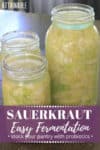Sauerkraut is one of the easiest ferments to get started with, and the results are delicious and packed with boatloads of health benefits. This green or red cabbage sauerkraut recipe is a delicious addition to sandwiches or an easy side dish.
Plus, this homemade sauerkraut recipe is far superior in taste to store bought brands.
Originally published in 2017; this post has been completely updated and revised.
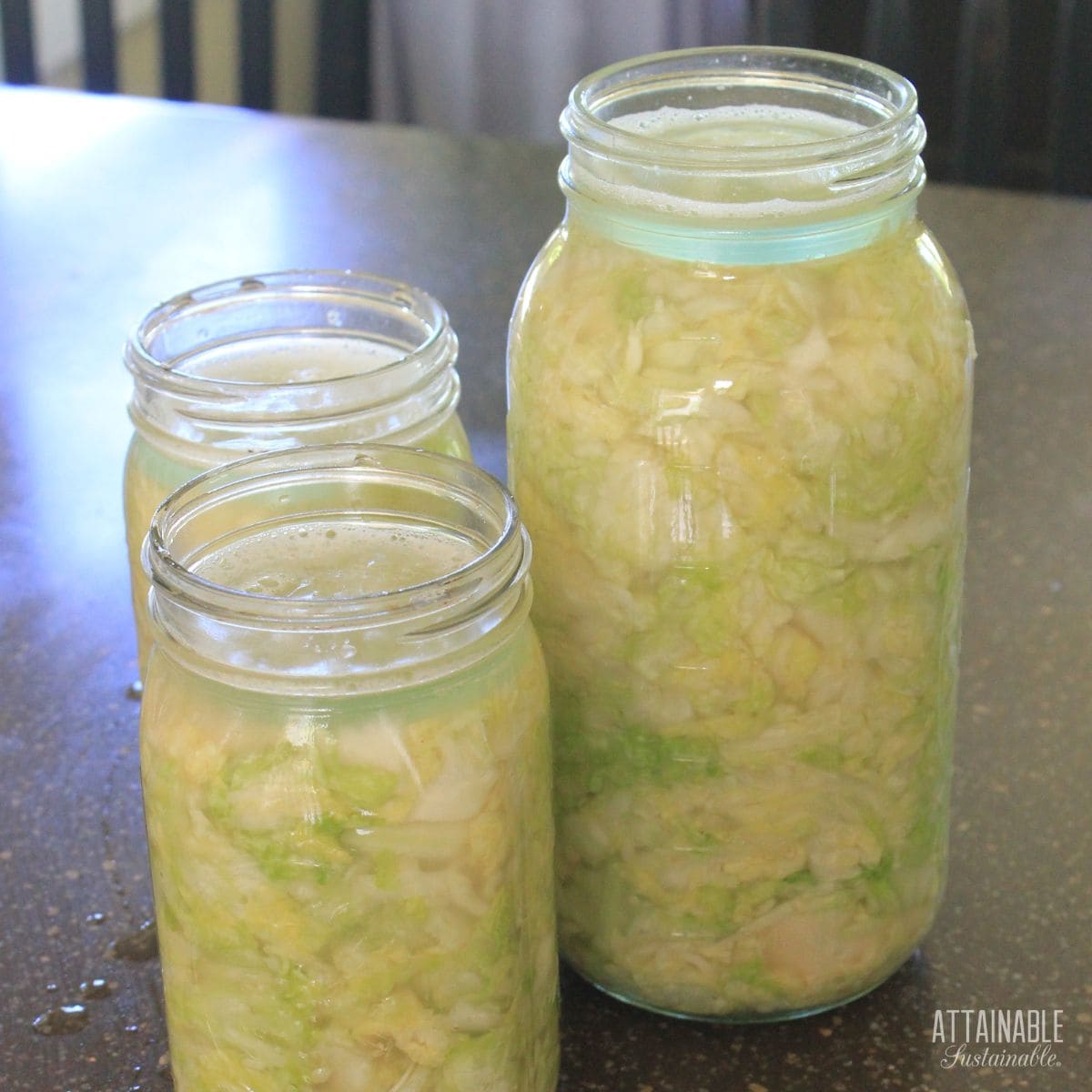

There’s a lot of information about fermenting cabbage here, but the too long, didn’t read version would look something like: Shred cabbage, toss with salt, pack into jars. Now, I’m not suggesting that you skip all of the information below — it’s valuable and you do need to get the salt and cabbage quantities right — but I’m pointing out that this really is a quick sauerkraut recipe.

 Ready to DIY your pantry with more wholesome ingredients? Check out my new book from National Geographic! Attainable Sustainable Pantry is filled with delicious recipes for some of your favorite condiments, snacks, and toppings, along with an entire section on home food preservation. It’s the guide you need to start skipping packaged products and embrace homemade.
Ready to DIY your pantry with more wholesome ingredients? Check out my new book from National Geographic! Attainable Sustainable Pantry is filled with delicious recipes for some of your favorite condiments, snacks, and toppings, along with an entire section on home food preservation. It’s the guide you need to start skipping packaged products and embrace homemade.Lacto-Fermentation
If you’re new to fermenting, it’s all about the lactic acid. Lactic acid is a natural preservative that keeps food from spoiling. It’s the byproduct of naturally occurring bacteria, which consume the starches and sugars in fruits and vegetables.
Naturally fermented sauerkraut can help promote the growth of beneficial bacteria throughout the intestine. Food that has been lacto-fermented is easier to digest and has increased levels of vitamins and beneficial enzymes.
5 Easy Steps to Transform Your Pantry!
Ready to switch from store bought to homemade? Let me help you make some changes! Grab my FREE five-part guide to getting started.
Get the Guide!
The lacto-fermentation process needs an anaerobic (or oxygen-free) environment in order to thrive and ferments best at 60-70 degrees F.
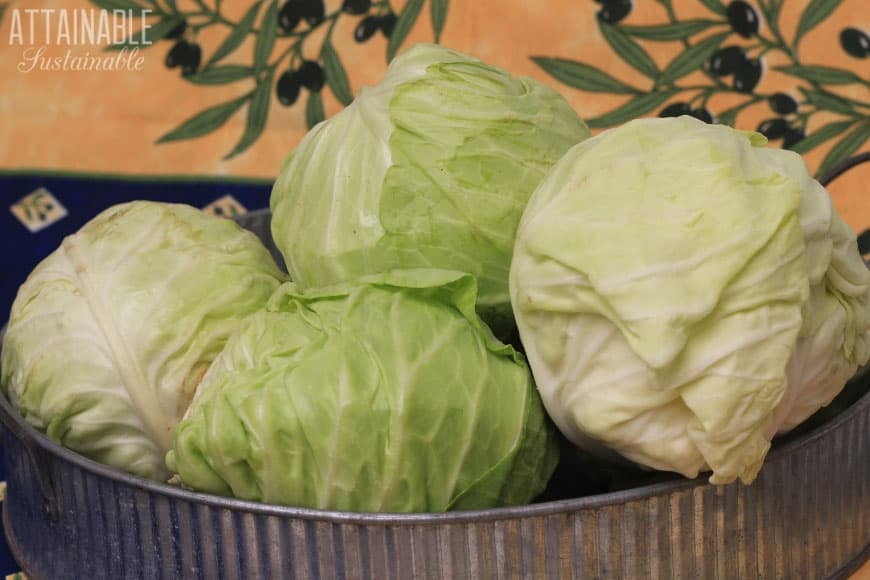

For this homemade sauerkraut recipe, you’ll wash and cut up the veggies, mix them with salt, and pound them to release their juices. The salt inhibits the growth of bad bacteria until enough lactic-acid is produced to naturally preserve the food.
Once fermentation has taken place, it’s halted by storing the ferment in cold storage or the refrigerator at an ideal temperature of 40 degrees F.
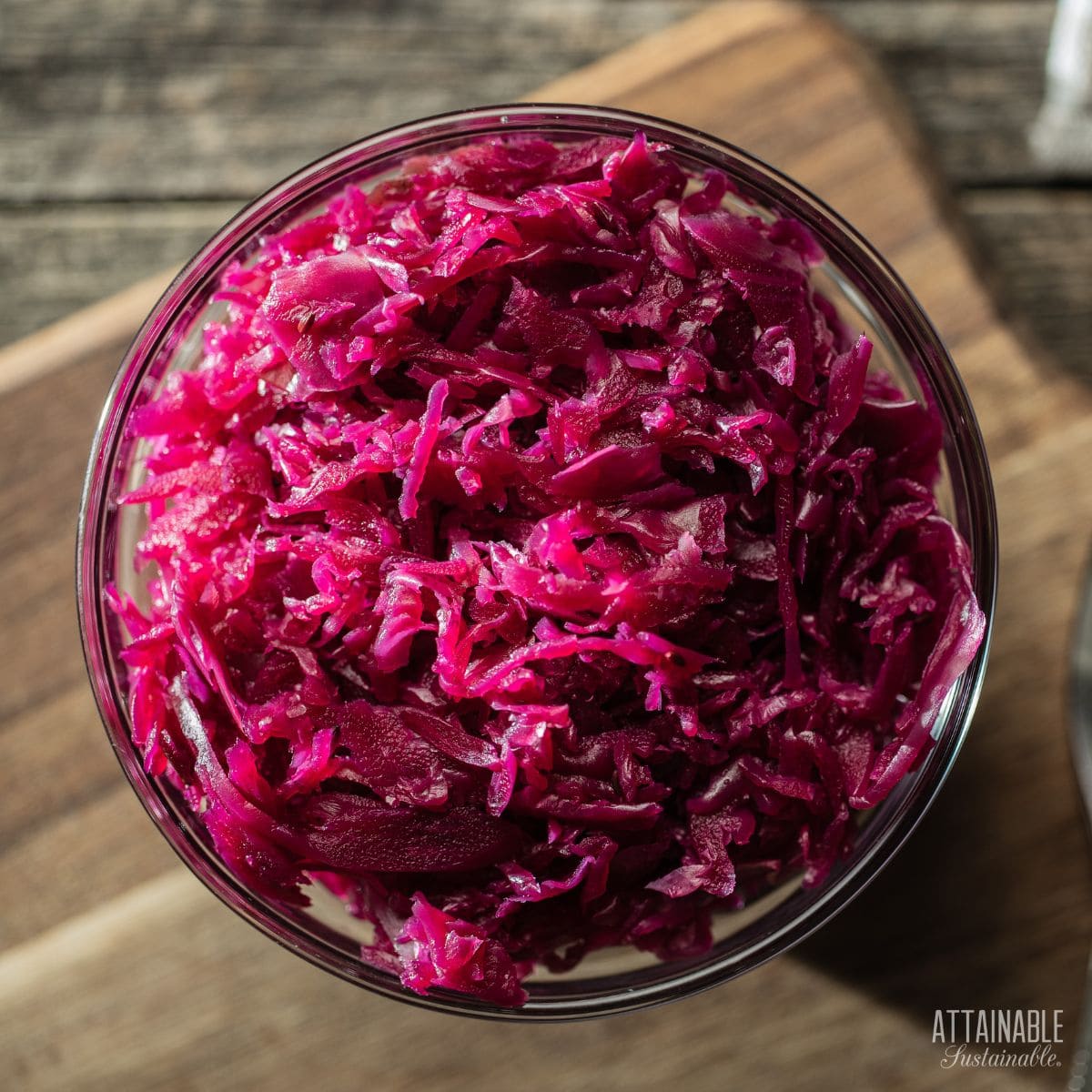

Ingredients and Supplies
Cabbage — You can use either green or red cabbage for this sauerkraut recipe, or even Napa cabbage.
Salt — Use a high quality salt, such as pink himalayan or Celtic sea salt when making this quick sauerkraut recipe. Avoid plain table salt.
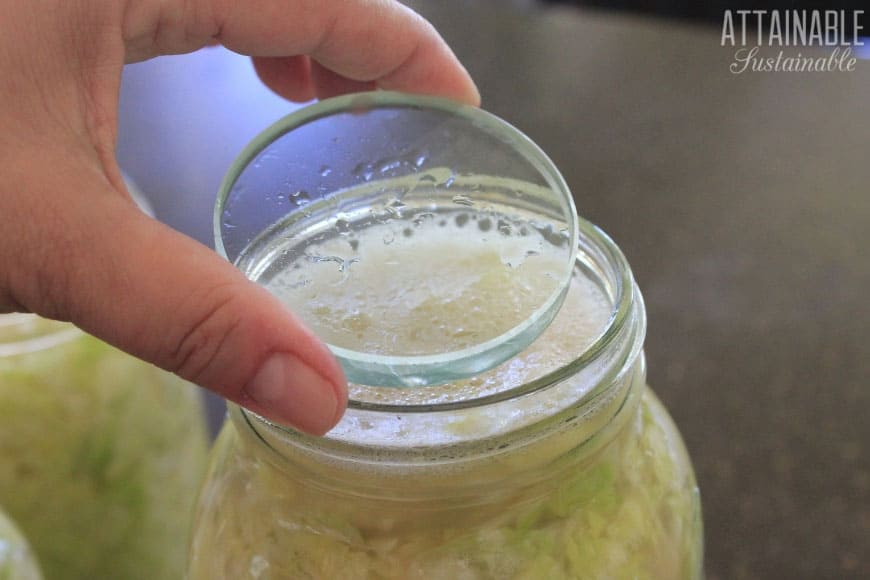

How to Make Quick Sauerkraut
I highly recommend using a scale to determine the salt to cabbage ratio. The weight of a single head of cabbage can vary drastically, altering the ratio.
Core and shred the cabbage and add to a very large bowl. For every 3 pounds of shredded, prepared cabbage, add 1 ounce of salt.
Use clean hands to squeeze and press the cabbage and distribute the salt. You’ll notice that the cabbage will start to release liquid. This is what you want.
Add the massaged cabbage to jars, pressing it firmly into the container and ensuring the liquid covers the cabbage. You can use an upcycled glass jar or Mason jars.
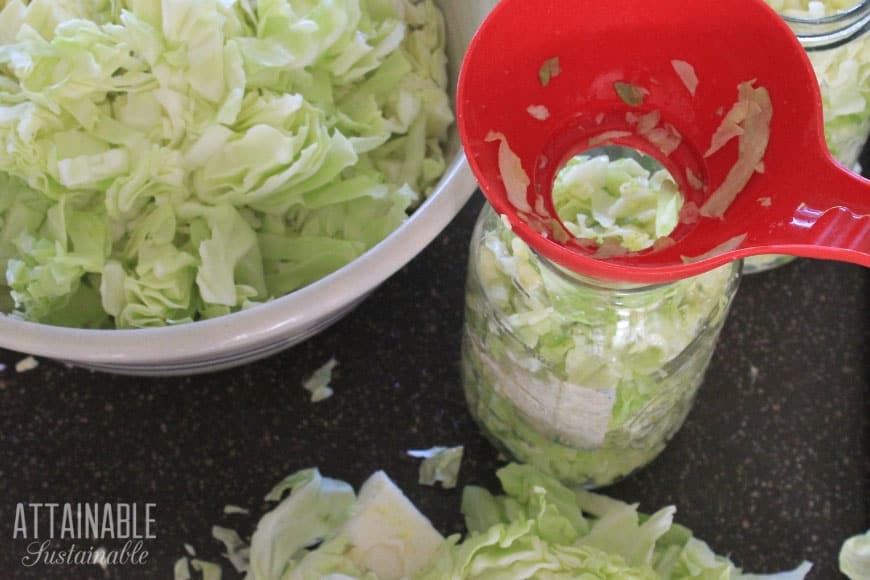

Leave headspace and add weights if using, then cover.
Fermenting Temps
Keep at room temperature (out of direct sunlight) for about a week. The time required to transform the cabbage into sauerkraut will vary a bit depending on the temperature of the kitchen. If it’s warmer, the process will happen faster.
If it gets too hot, it will ferment too quickly, resulting in a mushy final product. If the temperature is too cold, it may take weeks on end before it’s ready for cold storage.
You’ll begin to see bubbling, and the liquid in the jar may overflow. If it does, be sure to press the cabbage down so that it remains under the liquid. If necessary, add a bit of brine to cover the veggies.
Basic fermenting brine: Dissolve 1 to 3 tablespoons of sea salt in a quart of filtered water.
Fermenting at Home
- Use the freshest cabbage you can get your hands on. The fresher your veggies, the more crisp your final results will be.
- If you don’t have any fermenting weights, you can save an outer leaf of the cabbage and use that to hold the shredded cabbage under the liquid. Be sure it stays completely submerged during the fermentation period. Once fermentation is complete, you can remove the leaf and move jar to cold storage.
- Set your fermenting vessel on a plate or tray. Sometimes, as fermentation occurs, bubbles will cause the brine to spill out over the top of the jar. This makes a big mess unless you’re prepared for it.
- Check your ferment daily during the fermentation process to make sure all cabbage is submerged. If any pieces rise above the brine, push them back down and weight them under the brine.
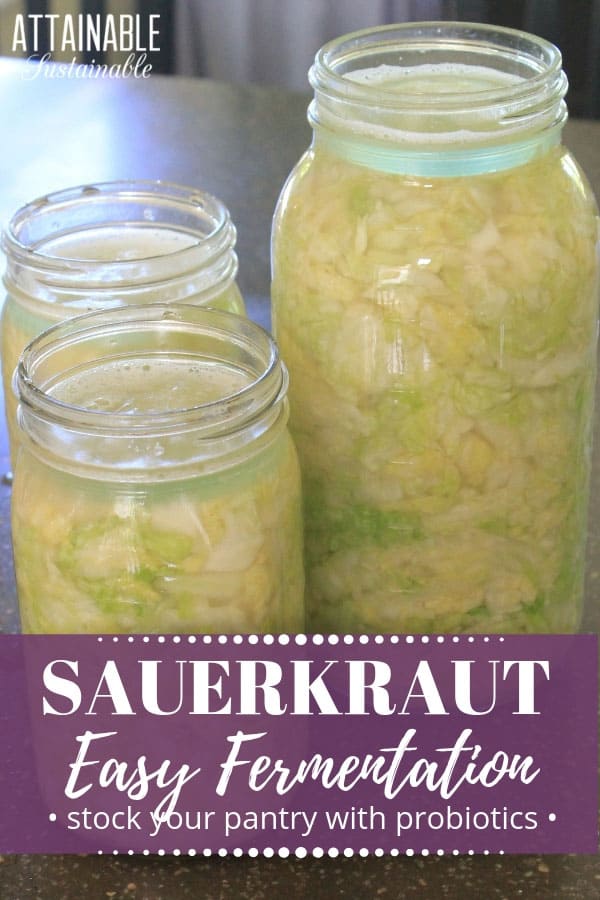

- If you see a white film accumulate on the top of the brine, it’s likely it’s kham yeast. Kham yeast is normal and not dangerous, but you will want to get rid of it. Simply take a clean paper towel and blot it off the surface. Then, take another clean paper towel, dip it into the brine and wipe around the inside edges of the jar. If the kahm yeast reappears, repeat this step as necessary.
- As you’re checking your fermenting sauerkraut, keep a close eye out for any fuzzy mold (either white, green or brown). If all cabbage remains submerged and the inside of the jar is clean you should have no problems with mold. But if any appears, you’ll need to discard the batch and start again.
Enjoying your Homemade Sauerkraut Recipe
You can serve sauerkraut hot or cold, but heating the kraut will kill the probiotics. Raw sauerkraut is excellent served alongside most meat dishes, added to sandwiches, and of course, for topping hot dogs. Go here for more ideas on what to eat with sauerkraut.
★ Did you make this homemade sauerkraut recipe? Don’t forget to give it a star rating below! ★


- 2 medium cabbage red cabbage, purple cabbage, or green cabbage
- 3-4 tablespoons sea salt or kosher salt
-
If you have a kitchen scale, use 1 ounce of salt per 3 pounds of prepared cabbage. If you do not have a kitchen scale, use the measurements listed above.
-
Remove outer leaves of cabbage, core and shred cabbage, and place into a large bowl.
2 medium cabbage
-
Add salt. Massage cabbage with clean hands for five to ten minutes until juices are released.
3-4 tablespoons sea salt
-
Put cabbage into wide mouth jars and, using clean hands or a utensil, press cabbage down until juices cover the top of the cabbage.
-
Leave 1-2 inch head-space at the top of the jar.
-
Add weights to hold the shredded cabbage under the brine.
-
Store at room temperature for about a week, monitoring the liquid level to be sure the solids remain submerged. The number of days required will vary depending on the temperature. If you like it more sour, allow it to ferment a little longer.
-
Sauerkraut can be eaten immediately, or continued to age for even better flavor.
-
Store fermented cabbage in the refrigerator with a jar lid in place.
- When making homemade sauerkraut (or any ferment) be sure all equipment and supplies are very clean. Even if they were clean and in your cupboards, give the jars and equipment a rinse in very hot water.
- It’s crucial that the cabbage remain covered by liquid as it ferments, to avoid mold. Check your ferment daily to make sure all cabbage is submerged. If any pieces rise above the brine, push them back down and weight them under the brine.
- Setting the jars on a plate or tray is a good idea; fermenting sauerkraut can overflow when it’s in its most active stage.
- Serve your homemade sauerkraut alongside any meal, or use it in some of these recipes.
- When you finish eating a jar of this yummy quick sauerkraut recipe, retain the leftover brine. This can be added to your next batch to speed the fermentation process.
Calories: 38kcal | Carbohydrates: 9g | Protein: 2g | Fat: 0.2g | Saturated Fat: 0.1g | Polyunsaturated Fat: 0.03g | Monounsaturated Fat: 0.03g | Sodium: 1476mg | Potassium: 258mg | Fiber: 4g | Sugar: 5g | Vitamin A: 148IU | Vitamin C: 55mg | Calcium: 61mg | Iron: 1mg
Originally contributed by Kelsey Steffen; this post has been thoroughly revised and updated.
